Understanding NFPA mandates and the benefits and drawbacks of steel fire sprinkler pipe
Automatic fire sprinkler systems are installed or retrofitted in nearly every type of property, from hotels to offices to single-family homes. Thus, fire sprinkler system pipe material must be versatile, easy to install, cost-effective, and—above all—reliable to meet the needs of this diverse market.
Steel has traditionally been the material of choice for fire sprinklers, although thermoplastic pipes now dominate residential and other light-hazard categories. But with so many choices—and so much at stake—how do you know which fire sprinkler pipe will stand up best to the unique demands of your property during a fire?
Previously, we have examined piping trends in home sprinkler systems. In this blog, we explore the pros and cons of one of the most popular piping materials for commercial systems—steel—to help you make an informed choice. You can also check out this blog that examines CPVC and copper fire sprinkler pipe.
Feel free to check out our selection of piping components and installation tools such as CPVC pipe fittings, pipe hangers, pipe sealants, pipe cutting tools, as well as other parts and accessories for commercial and residential sprinkler systems.
NFPA permits listed metallic and nonmetallic fire sprinkler pipe
Before we examine the types of pipe, let’s provide some perspective. The 2019 edition of NFPA 13: Standard for the Installation of Sprinkler Systems (7.3.1.1) permits listed metallic and nonmetallic materials for sprinkler pipe and tubing that meet or exceed the following American Society for Testing and Materials (ASTM) standards:
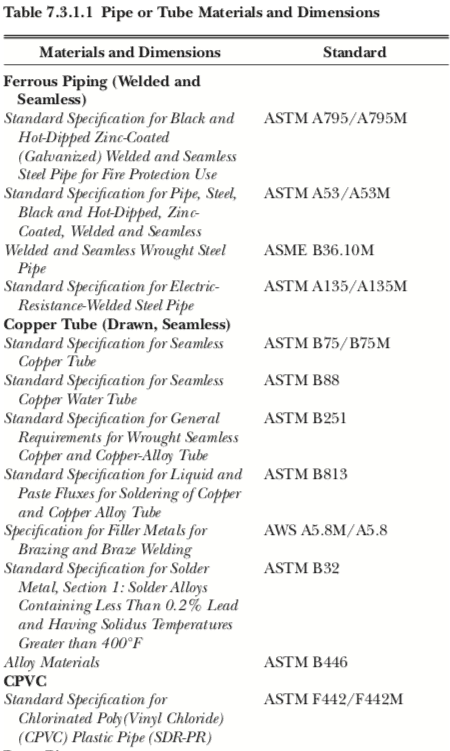
But read this carefully: not all pipe or tubing that meets these standards is also listed for fire sprinkler service. Pipes that are “listed” have been rigorously tested and found to meet the safety standards of a third-party certification agency. Metal pipes are listed to UL 852 and thermoplastic pipes are listed to UL 1821.
Listed pipes are easily identified by the listing agency’s logo. If listed materials differ from Table 7.3.1.1, NFPA 13 permits their use as long as installers adhere to any limitations in the listing. To ensure there are no mistakes, NFPA 13 requires manufacturers to include listing limitations in their installation instructions.
From the 2019 edition of NFPA 13
7.3.2 * Nonmetallic pipe and tubing
7.3.2.1 Nonmetallic pipe in accordance with Table 7.3.1.1 shall be investigated for suitability in automatic sprinkler installations and listed for this service.
7.3.2.1.1 Other types of nonmetallic pipe or tube investigated for suitability in automatic sprinkler installations and listed for this service, including but not limited to CPVC, and differing from that provided in Table 7.3.1.1 shall be permitted where installed in accordance with their listing limitations.
7.3.2.1.2 Manufacturer’s installation instructions shall include its listing limitations.
7.3.3 * Listed Metallic Pipe and Tubing.
7.3.3.1 Other types of pipe or tube investigated for suitability in automatic sprinkler installations and listed for this service, including steel, and differing from that provided in Table 7.3.1.1 shall be permitted where installed in accordance with their listing limitations, including installation instructions.
But while NFPA 13 determines which piping materials are acceptable overall—and safety organizations such as UL (formerly Underwriter Laboratories) specify which ones will perform reliably at different hazard levels—property owners can still choose among several materials for commercial applications.
First, determine which hazard level your property falls into. Most offices, for instance, are “light hazard” and can choose any of these pipes, but businesses that regularly contain more combustible materials such as doctors’ offices, restaurants, food stores, and manufacturing plants have higher hazard levels and thus cannot use thermoplastic pipes.
The table below sums up important differences between the most popular piping materials:
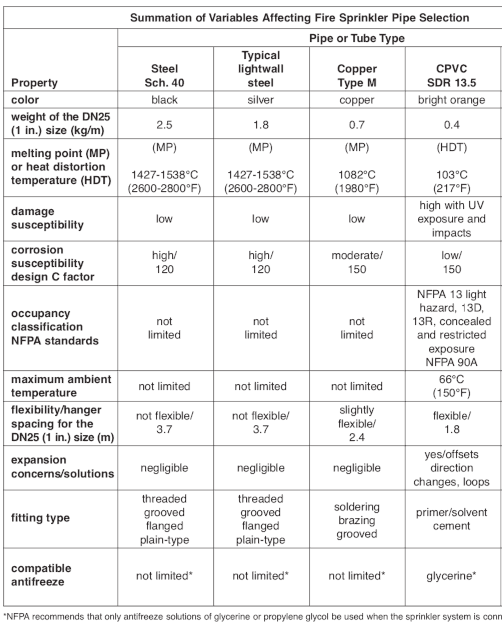
Let’s dig deeper into the pros and cons of these fire sprinkler system pipe materials, starting with steel:
Black steel dominates the fire sprinkler market, but corrosion is a serious concern
Since the first fire protection systems were installed, the strength, durability, and extreme resistance to heat exhibited by black steel has made it the traditional leader of the fire sprinkler pipe market. With a melting point that falls between a whopping 2,600°F and 2,800°F (1,427°C and 1,538°C), steel pipe can withstand the heat of a burning building and keep water flowing onto a fire.
Steel pipe is suitable for all fire protection systems. It’s easily formed, bent, and fabricated, enabling it to be manufactured into various sizes, shapes, and configurations.
It also boasts the lowest coefficient of thermal expansion among fire sprinkler system pipe materials. This coefficient describes how the size of an object changes with a temperature change. For instance, a 100-foot section of steel pipe will only expand 0.63 of an inch when heated from 40°F to 120°F, minimizing the need for expansion loops and joints, according to a National Institute of Standards and Technology (NIST) report. By comparison, while copper carries the next-best coefficient of thermal expansion, it’s still 1.5 times higher.
Steel offers many other benefits as well. Extended exposure to ultraviolet light has no impact on its mechanical properties or performance. It can also be painted with no adverse effects.
Steel’s strength and rigidity mean that dropping, stepping on, or banging steel pipes during installation will not easily cause damage, which can be a concern with CPVC. Rigidity is also important because it determines the distance between hangers during installation. More flexible materials require more hangers, upping the cost of that component of an installation.
Steel’s rigidity creates challenges, however, when pipe must be routed around obstacles during installation. Rigidity exerts high forces on anchors as well. Steel is also the heaviest material, increasing the difficulty of installation because more people are often needed to move it.
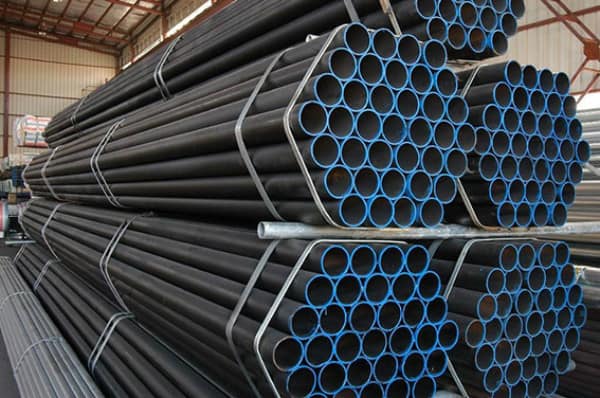
For decades, sprinkler pipe was predominantly schedule 40 black steel pipe. But in the mid-1970s, a fencing manufacturer, Allied Tube and Conduit, sparked a long debate about the necessary pipe wall thickness for fire protection. Allied wanted to expand its business by applying the thinner but strong and durable steel pipe it used for fences to fire sprinklers. And since sprinkler water is essentially stagnant until a fire occurs, it argued, why couldn’t thinner pipe be used?
Eventually, the NFPA paved the way for the acceptance of thinner—and thus lighter weight—steel pipes by adding a provision to its standard that allows any material certified by a testing laboratory to be used in sprinkler systems.
From the 2019 edition of NFPA 13
16.3.4 Specially Listed Steel Pipe. Pressure limitations and wall thickness for steel pipe specially listed in accordance with 7.3.3 shall be permitted to be in accordance with the pipe listing requirements.
But steel pipes have a major drawback: they are more susceptible to corrosion than any other fire sprinkler system pipe material, and damage can begin as soon as a system is installed. The presence of water, oxygen, and metal creates the ultimate breeding ground for rust to form. This “corrosion triangle” also contributes to microbiologically induced corrosion (MIC), allowing bacteria to colonize the internal surfaces of steel pipes.
Corrosion prompts costly service calls to fix obstructed pipes, repair leaky holes, and remove loose scale or rust that clog sprinklers and valves and degrade the system’s flow characteristics. Steel’s susceptibility to corrosion-caused pitting and buildup earns it the lowest hydraulic C-factor, which measures the roughness on the inside of pipes and its ability to impede water flow. Black steel pipes have a C-factor of 120 in wet systems, while the more corrosion-resistant copper and CPVC pipes boast C-factors of 150.
Left untreated, corrosion triggers leaks or accidental sprinkler discharges, potentially causing tens of thousands of dollars in water damage to the property the system was meant to protect. And it can cause fire sprinklers to fail during a fire.
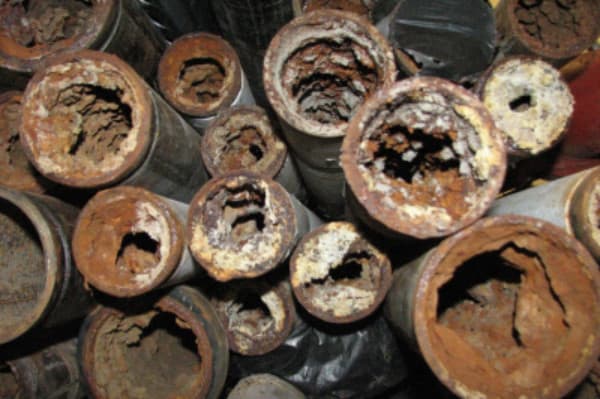
The problem is the most severe in dry sprinkler systems which rely on pressurized air to hold back the water supply and keep pipes from freezing in cold temperatures. Water isn’t supposed to enter dry pipes until sprinkler heads activate. But condensation and the annual trip test required by NFPA 25: Standard for the Inspection, Testing, and Maintenance of Water-Based Fire Protection Systems make it nearly impossible to keep dry systems completely dry. The C-factor of steel drops to 100 in dry systems.
More than 70 percent of dry sprinkler systems suffer significant corrosion issues within 12.5 years of installation, according to a Potter Corrosion Solutions report. But that doesn’t mean wet systems escape unscathed: 35 percent of them experience significant issues after 25 years.
NFPA 13 (A.7.3.3) notes that corrosion generally impacts steel pipes with thinner walls the fastest, reducing their effective lifespan compared to thicker schedule 40 pipes.
Replacing pressurized air with nitrogen in dry systems can dramatically improve the lifespan of steel pipes by eliminating a critical leg of the corrosion triangle. Read our previous blog to learn more about the benefits of nitrogen for dry systems. You can also check out our guide to mitigating and fixing corrosion in fire sprinkler pipe.
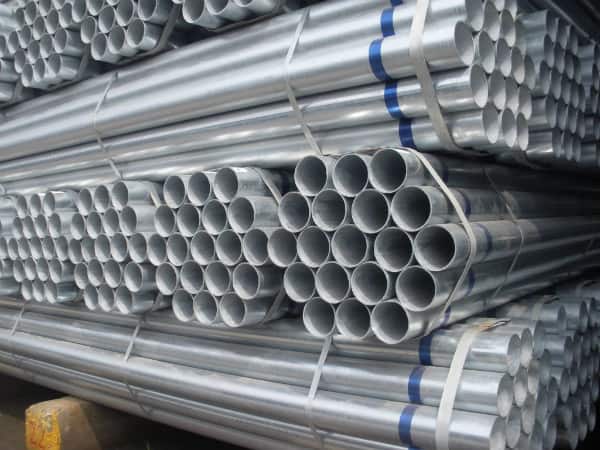
While effective for preventing corrosion in other uses, galvanized steel fails faster in fire sprinklers
Two decades ago, galvanized steel was touted as a miracle solution against the impact of corrosion on metal pipes. Galvanized steel pipes are coated with zinc. Since zinc is more reactive than steel, it’s intended to serve as a sacrificial material when corrosion strikes, creating a protective layer of scale build-up while protecting the piping underneath.
The theory was so widely accepted that the NFPA considered a requirement that all steel pipe used in dry sprinklers systems be internally galvanized.
But here’s the thing: while galvanized steel can be an excellent means of preventing corrosion on street signs and guard rails where it’s given the opportunity to dry out, persistently moist, oxygenated conditions cause it to corrode aggressively, according to a Sprinkler Age report. Studies have shown pinhole leaks developing in dry systems with galvanized steel pipes within two years of installation—and ruptures within four years, according to Potter Corrosion Solutions.
Even worse, the corrosion process causes galvanized steel to shed Zn2+ ions into the discharge water when dry or preaction sprinkler systems are tested, creating a heavy metal contamination environmental hazard. Sprinkler Age reports that many municipalities prohibit discharges of water containing more than 30 mg/L of Zn2+, and most discharged water from galvanized dry and preaction fire sprinkler systems contains 1000-plus mg/L of Zn2+.
In 2013, NFPA 13 reversed a previous decision to boost the hydraulic C-factor of galvanized steel pipes in dry systems from 100 to 120, recognizing that it did not offer any more corrosion benefits than bare black steel pipe. Galvanized steel retains its C-factor of 120 in wet systems.
In 2016, NFPA 13 also removed its requirement that steel pipe used with control mode specific application (CMSA) sprinklers must be internally galvanized, a mandate that had been in place since large drop sprinklers were first permitted for dry pipe systems in 1991.
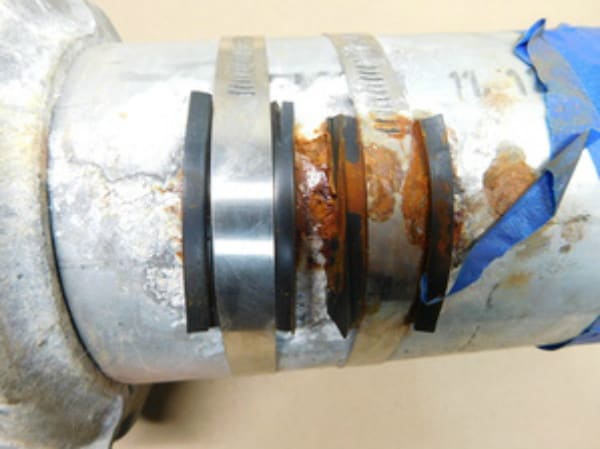
Other standards followed suit. In 2016, the U.S. Department of Defense banned the use of galvanized steel piping in the majority of its fire protection systems. It also required black steel to replace galvanized steel when additions, replacements, or relocations are made. A year later, the U.S. Government Services Administration prohibited galvanized steel pipes in dry sprinkler systems.
Once again, it’s important to note that removing oxygen from dry systems and replacing it with pressurized nitrogen can significantly increase the lifespan of galvanized pipes—enabling property owners to enjoy the many other benefits of this steel in their fire sprinklers. NFPA 13 also maintains that galvanized steel pipe, fittings, and hangers might be suitable for exterior uses “when moisture conditions are severe but corrosive conditions are not of great intensity” (A.16.4.2.1). It adds, however, that exposed material should be given a protective paint coating.
At the end of the day, NFPA 13 has not banned listed galvanized steel from fire sprinkler pipes. It references its use for other specific applications as well, including cooling tower fire sprinklers, marine supply system piping, and piping to water motor-operated devices and pressure-actuated alarm-initiating devices.
Stay tuned to learn about more types of fire sprinkler pipe
Using the right pipes is essential to your fire sprinkler’s ability to control and extinguish a fire—and steel is a commonly used fire sprinkler system pipe material that’s a good choice in many applications, as long as the potential for corrosion is accounted for.
Our next installment of this series on fire sprinkler pipe material covers two other popular choices:
- Copper pipe: More expensive than steel but it’s smoother and more resistant to corrosion.
- CPVC pipe: Inexpensive, flexible, and it has the highest corrosion resistance—but it’s only for use in light-hazard settings
Looking to install sprinkler pipes? Check out our selection of piping components such as CPVC pipe fittings, pipe hangers, pipe sealants, and pipe cutting tools for commercial and residential sprinkler systems.
Questions about QRFS products or need a brand or item not in our online inventory? Just call us at +1 (888) 361-6662 or email support@qrfs.com.
This blog was originally posted at blog.qrfs.com. Check us out at Facebook.com/QuickResponseFireSupply or on Twitter @QuickResponseFS.


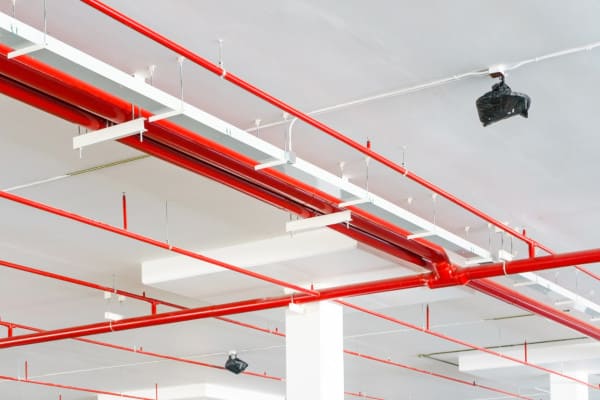

The way you discussed the topic with ease and completeness is really amazing. Thanks for this article!
This blog is really very informative and I really appreciate that you shared this content.
Hi
Is there any reason not to connect galvenzied pipe with black cast iron roll grooving couplings?
Thanks
M. Saad
Thanks for reaching out. Connections are dependent on the specifics of your system and your local fire standards. We recommend working with your local authority having jurisdiction to confirm if the connection meets local fire safety standards.
It is great blog post. I am Always read your blog. Helpful and Informative blog. Thanks for sharing these information with us.
What about the PPR PIPE it can be use for fire spirkler system ? or Isn’t ? for example the two stories building .. I am hoping for your response ,Thank you ….
Cyrux — Currently, CPVC and PEX are only approved per NFPA 13D (residential) and CPVC only under NFPA 13 (commercial, but only light hazard settings). Thanks!
For a 13 Floor, high rise building having 3 basement as well, hydrant loop is running below slab. i opted for MS schedule 40 pipe. please confirm if it should be seamless or seamed. thank you.
Tayyabla —
Unfortunately, we don’t know the answer without engaging one of our fire pros to do some research, and QRFS’s Ask a Fire Pro service is paused for technical maintenance. But regarding what NFPA 13 (2022 edition) says, we hope this may point you in the right direction:
Section 16.3.7 specifies that Schedules 10S or 40S pipe shall be used, so you should be good with the latter.
If the pipe qualifies as underground pipe, section 6.1.1.1 specifies that stainless steel pipe must meet the requirements in ASTM A312/312M, with commentary otherwise specifying “Both coating and wrapping are required when internally galvanized steel pipe is used underground between an exterior fire department connection and the check valve where it connects to the system.”
If the pipe is aboveground, Table 7.3.1.1 specifies stainless steel pipe also complies with ASTM A312/312M.
We are not aware of references to seamless vs. seamed in NFPA 13, though there are numerous rules on joining methods and coatings. Thus, we suggest that you closely check out ASTM A312/312M to review the specs and look for references. We hope that helps somewhat, and thank you for reading.
Dear,
We have developed a fireproof composite GRP pipe for using instead of steel sprinkler pipes. Also we have a test method for this type of pipe. It includes itself some tests for using in dry and wet systems. In the test we are using cellulosic and hydrocarbon curves with the heat flux = 145 kWt/m2 to provide conditions close to real. The current standards UL 1821 or FM 1635 describe only thermoplastic pipes such as CPVC, PP-R and others.
Would you suggest us, how we can approve our an innovation pipe for NFPA codes?
Valentin — Interesting. We are not qualified to comment on the fire protection performance and standards relating to a new material. Honestly, your best bet would be to contact the testing organizations and perhaps qualified fire protection engineers to discuss it. Organizations like UL and FM can also comment on the process to get a material that is not an explicit thermoplastic tested and listed. Best of luck!
Dear Valentin
Can you please tell me about this product? Has it been used anywhere?